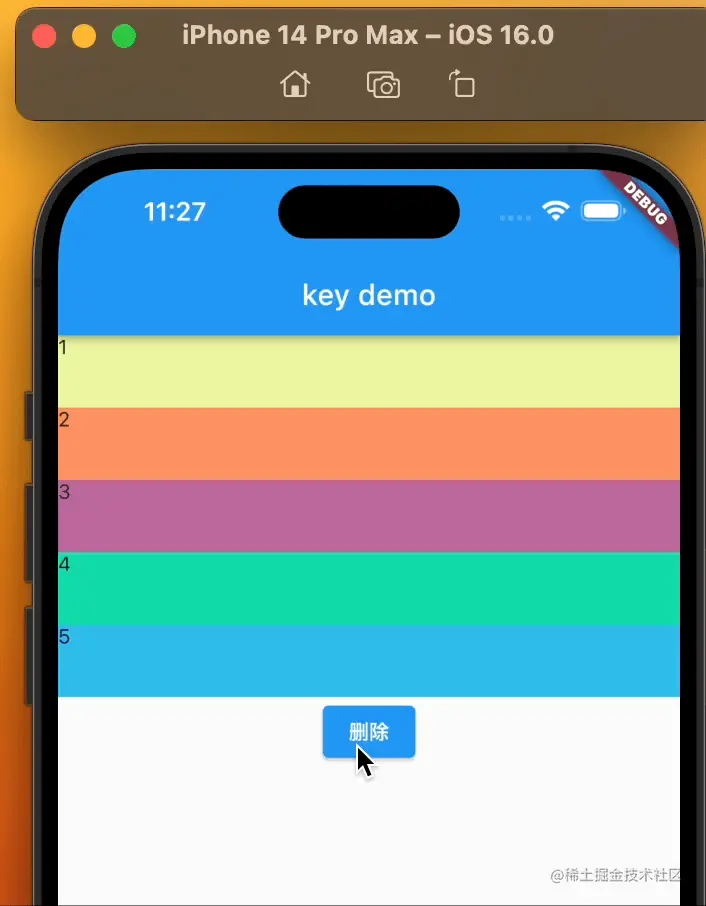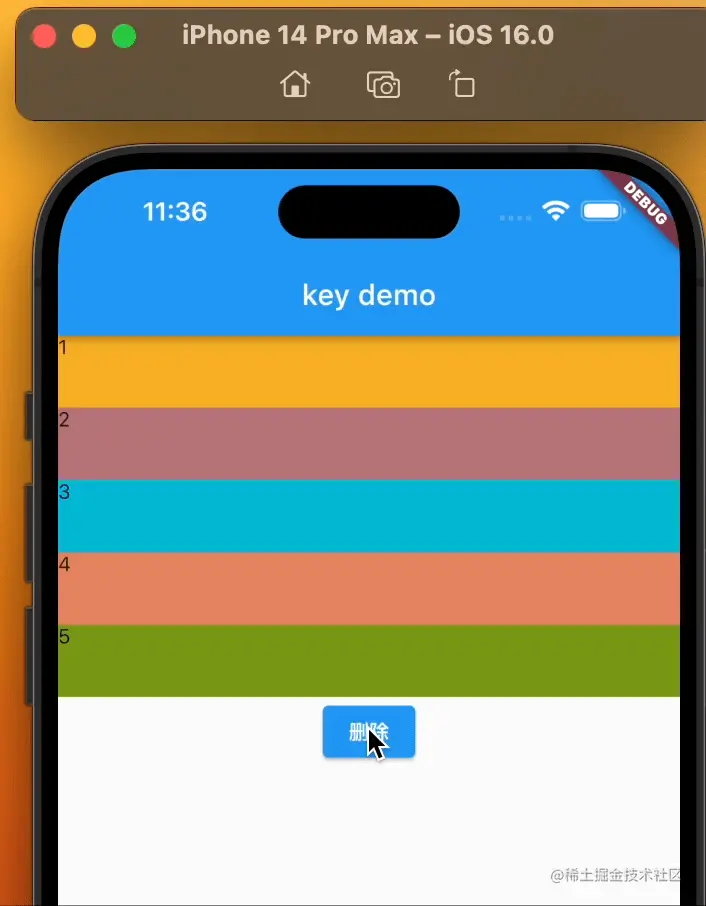Widget中有个可选属性key,顾名思义,它是组件的标识符,当设置了key,组件更新时会根据新老组件的key是否相等来进行更新,可以提高更新效率。但一般我们不会去设置它,除非对某些具备状态且相同的组件进行添加、移除、或者排序时,就需要使用到key,不然就会出现一些莫名奇妙的问题。
例如下面的demo:
import 'dart:math';
import 'package:flutter/material.dart';
void main() {
runApp(const MyApp());
}
class MyApp extends StatelessWidget {
const MyApp({Key? key}) : super(key: key);
@override
Widget build(BuildContext context) {
return MaterialApp(
title: 'test',
home: Scaffold(
appBar: AppBar(
title: const Text('key demo'),
),
body: const KeyDemo(),
),
);
}
}
class KeyDemo extends StatefulWidget {
const KeyDemo({Key? key}) : super(key: key);
@override
State<StatefulWidget> createState() => _KeyDemo();
}
class _KeyDemo extends State<KeyDemo> {
final List<ColorBlock> _list = [
const ColorBlock(text: '1'),
const ColorBlock(text: '2'),
const ColorBlock(text: '3'),
const ColorBlock(text: '4'),
const ColorBlock(text: '5'),
];
@override
Widget build(BuildContext context) {
return Column(
children: [
..._list,
ElevatedButton(
onPressed: () {
_list.removeAt(0);
setState(() {});
},
child: const Text('删除'),
)
],
);
}
}
class ColorBlock extends StatefulWidget {
final String text;
const ColorBlock({Key? key, required this.text}) : super(key: key);
@override
State<StatefulWidget> createState() => _ColorBlock();
}
class _ColorBlock extends State<ColorBlock> {
final color = Color.fromRGBO(
Random().nextInt(256), Random().nextInt(256), Random().nextInt(256), 1.0);
@override
Widget build(BuildContext context) {
return Container(
width: double.infinity,
height: 50,
color: color,
child: Text(widget.text),
);
}
}

点击删除按钮,从ColorBlock的列表中删除第一个元素,可以观察到颜色发生了错乱,删除了1号色块,它的颜色状态转移到了2号身上。这种情况在实际开发中往往会造成不小的麻烦。
这时,就需要为每个ColorBlock设置key值,来避免这个问题。
final List<ColorBlock> _list = [
const ColorBlock(key: ValueKey('1'), text: '1'),
const ColorBlock(key: ValueKey('2'), text: '2'),
const ColorBlock(key: ValueKey('3'), text: '3'),
const ColorBlock(key: ValueKey('4'), text: '4'),
const ColorBlock(key: ValueKey('5'), text: '5'),
];

点击删除按钮,可以看到颜色错乱的现象消失了,一切正常。那么有没有想过,为什么ColorBlock有key和没key会出现这种差异?
我们来简单分析下key的更新原理。
首先,我们知道Widget是组件配置信息的描述,而Element才是Widget的真正实现,负责组件的布局和渲染工作。在创建Widget时会对应的创建Element,Element保存着Widget的信息。
当我们更新组件时(通常指调用setState方法)会遍历组件树,对组件进行新旧配置的对比,如果同个组件信息不一致,则进行更新操作,反之则不作任何操作。
/// Element
Element? updateChild(Element? child, Widget? newWidget, Object? newSlot) {
if (newWidget == null) {
if (child != null)
deactivateChild(child);
return null;
}
final Element newChild;
/// 更新逻辑走这里
if (child != null) {
bool hasSameSuperclass = true;
if (hasSameSuperclass && child.widget == newWidget) {
if (child.slot != newSlot)
updateSlotForChild(child, newSlot);
newChild = child;
} else if (hasSameSuperclass && Widget.canUpdate(child.widget, newWidget)) {
/// 判断新旧组件为同一个组件则进行更新操作
if (child.slot != newSlot)
updateSlotForChild(child, newSlot);
child.update(newWidget);
newChild = child;
} else {
deactivateChild(child);
newChild = inflateWidget(newWidget, newSlot);
if (!kReleaseMode && debugProfileBuildsEnabled)
Timeline.finishSync();
}
} else {
/// 创建逻辑走这里
newChild = inflateWidget(newWidget, newSlot);
}
return newChild;
}
通过Element中的updateChild进行组件的更新操作,其中Widget.canUpdate是判断组件是否需要更新的核心。
/// Widget
static bool canUpdate(Widget oldWidget, Widget newWidget) {
return oldWidget.runtimeType == newWidget.runtimeType
&& oldWidget.key == newWidget.key;
}
canUpdate的代码很简单,就是对比新老组件的runtimeType和key是否一致,一致刚表示为同一个组件需要更新。
结合demo,当删除操作时,列表中第一个的组件oldWidget为ColorBlock(text: '1'),newWidget为ColorBlock(text: '2') ,因为我们将text和color属性都存储在State中,所以 oldWidget.runtimeType == newWidget.runtimeType为true,oldWidget.key == newWidget.key 为null,也等于true。
于是调用udpate进行更新
/// Element
void update(covariant Widget newWidget) {
_widget = newWidget;
}
可以看出,update也只是简单的更新Element对Widget的引用。 最终新的widget更新为ColorBlock(text: '2'),State依旧是ColorBlock(text: '1')的State,内部的状态保持不变。
如果添加了Key,刚oldWidget.key == newWidget.key为false,不会走update流程,也就不存在这个问题。
key有两个子类GlobalKey和LocalKey。
GlobalKey全局唯一key,每次build的时候都不会重建,可以长期保持组件的状态,一般用来进行跨组件访问Widget的状态。
class GlobalKeyDemo extends StatefulWidget {
const GlobalKeyDemo({Key? key}) : super(key: key);
@override
State<StatefulWidget> createState() => _GlobalKeyDemo();
}
class _GlobalKeyDemo extends State<GlobalKeyDemo> {
GlobalKey _globalKey = GlobalKey();
@override
Widget build(BuildContext context) {
return Column(
children: [
ColorBlock(
key: _globalKey,
),
ElevatedButton(
onPressed: () {
/// 通过GlobalKey可以访问组件ColorBlock的内部
(_globalKey.currentState as _ColorBlock).setColor();
setState(() {});
},
child: const Text('更新为红色'),
)
],
);
}
}
class ColorBlock extends StatefulWidget {
const ColorBlock({Key? key}) : super(key: key);
@override
State<StatefulWidget> createState() => _ColorBlock();
}
class _ColorBlock extends State<ColorBlock> {
Color color = Colors.blue;
setColor() {
color = Colors.red;
}
@override
Widget build(BuildContext context) {
return Container(
width: double.infinity,
height: 50,
color: color,
);
}
}
将组件的key设置为GlobalKey,可以通过实例访问组件的内部属性和方法。达到跨组件操作的目的。
LocalKey局部key,可以保持当前组件内的子组件状态,用法跟GlobalKey类似,可以访问组件内部的数据。
LocalKey有3个子类ValueKey、ObjectKey、UniqueKey。
可以使用任何值做为key,比较的是两个值之间是否相等于。
class ValueKey<T> extends LocalKey {
const ValueKey(this.value);
final T value;
@override
bool operator ==(Object other) {
if (other.runtimeType != runtimeType)
return false;
return other is ValueKey<T>
&& other.value == value;
}
/// ...
}
可以使用Object对象作为Key,比较的是两个对象内存地址是否相同,也就是说两个对象是否来自同一个类的引用。
class ObjectKey extends LocalKey {
const ObjectKey(this.value);
final Object? value;
@override
bool operator ==(Object other) {
if (other.runtimeType != runtimeType)
return false;
/// identical函数: 检查两个引用是否指向同一对象
return other is ObjectKey
&& identical(other.value, value);
}
/// ...
}
独一无二的key,Key的唯一性,一旦使用UniqueKey,那么将不存在element复用
class UniqueKey extends LocalKey {
UniqueKey();
@override
String toString() => '[#${shortHash(this)}]';
}
1、key是Widget中的唯一标识,如果列表中包含有状态组件,对其进行添加、移除、或者排序操作,必须增加key。以避免出现乱序现象。
2、出现乱序现象的根本原因是:新旧组件通过runtimeType和key进行对比,key为空的情况下,有状态组件runtimeType对比为true,造成组件更新后依然保持State内部的属性状态。
3、key分为GlobalKey和LocalKey,GlobalKey可以进行跨组件访问Widget,LocalKey只能在同级之下进行。